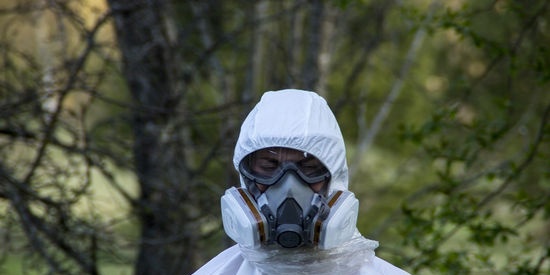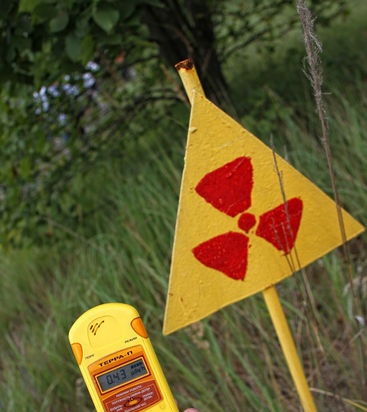|
 Few of even the most prominent experts in the field of atomic physics knew that morning of 1942 that man had finally mastered the secret control of a nuclear chain reaction. But three years later, in 1945, the world was shaken by the tragedy of the Japanese cities - Hiroshima and Nagasaki. Few of even the most prominent experts in the field of atomic physics knew that morning of 1942 that man had finally mastered the secret control of a nuclear chain reaction. But three years later, in 1945, the world was shaken by the tragedy of the Japanese cities - Hiroshima and Nagasaki.
It was over these cities that poisonous mushrooms of atomic explosions soared for the first time. And it was then that humanity learned - bitterly and palpably - about the destructive power of the atomic nucleus.
However, the study of the phenomenon of radioactivity and the effect of radiation on living tissues began much earlier - in 1896. At that time, the young French physicist Henri Becquerel became interested in salts containing the chemical element uranium.
The fact is that many uranium salts have the ability to phosphoresce when exposed to sunlight. Becquerel decided to study this property in more detail. He exposed uranium salts to sunlight and then put them on a photographic plate wrapped in black paper. It turned out that the rays of phosphorescence of uranium salts quite easily pass through the opaque paper, leaving a black spot on the plate after its development. Becquerel was the first to come to this conclusion. But it soon became clear that the phosphorescence rays had nothing to do with it. Uranium salts, even prepared and kept in the dark, still acted on the photographic plate for several months, and not only through paper, but even through wood, metals, etc. On the basis of these experiments, radioactivity was discovered. And two years later, two new radioactive elements, polonium and radium, were discovered by famous scientists, the spouses Maria and Pierre Curie. It was from this time that an intensive study of radioactivity began. But what is radioactivity?
We are accustomed from childhood that inanimate objects usually exist for centuries. In any case, if not the objects themselves, then the materials from which they are made. Judge for yourself: even if we broke a porcelain cup and it ceased to fulfill its intended role, then its shards can lie for millennia and, in principle, nothing will happen to them. After all, archaeologists are finding the remains of dishes and jewelry that people wore many millennia ago!

The whole point here lies in the extraordinary strength of the molecules of inorganic compounds and the particles that make them up - atoms. Indeed, individual atoms can exist for a very long time without undergoing any significant changes. Indeed, in order to destroy or "remake" an atom, you need to change its nucleus, and this is too difficult a task.
But in nature, it turns out, there are also atoms whose nuclei change spontaneously, spontaneously, as physicists say. It is these nuclei that were called radioactive, since, undergoing transformation, they emit rays. Thus, radioactivity is a physical phenomenon in which one or another rearrangement of atomic nuclei occurs. These are usually three types of rays. They were named the letters of the Greek alphabet: alpha, beta and gamma. Alpha and beta rays are streams of particles. In particular, alpha particles are atoms of the element helium, devoid of their electrons. Beta particles are a stream of electrons, while gamma rays are electromagnetic oscillations, somewhat similar in properties to X-rays. Thus, an atom of a radioactive element, ejecting an alpha or beta particle from the nucleus, turns into an atom of another element. So, for example, a radium atom, emitting an alpha particle, turns into an atom of an element called radon.
Studying radioactive elements (which, by the way, were not so few), scientists noticed two very interesting features. One of them consisted in the fact that the rate of decay (or, more precisely, transformation) of radioactive atoms of the same type is strictly constant and practically not influenced by any external factors. It depends only on the amount of available radioactive element. So, for example, if we have one gram of radium, then half of all available atoms will decay in exactly 1620 years. The remaining half gram will decay by half (that is, their number will be halved) also after 1620 years, etc. Moreover, the decay rate for each type of atom is strictly constant, and until two different types of radioactive atoms have been found that would have the same half-life (then is that period of time during which half of all atoms undergo transformation).
Another feature was that, as it turned out, radioactive rays are capable of acting on living tissues. And the first to discover it was the discoverer of radioactivity, Henri Becquerel. To demonstrate the glow of radium salts in the dark, he carried with him in his breast pocket a glass ampoule containing this salt. After a while, on his body, in the place opposite the ampoule, he discovered a slight reddening, resembling a slight burn, which then turned into a small sore. The scientist quite rightly attributed this phenomenon to the action of radioactive rays. By the way, the ulcer healed very slowly and completely healed only after many months. It was then, almost fifty years before Hiroshima and Nagasaki, that radioactive atoms warned people of their danger.

What does it consist of?
It turned out that the main danger is not the substances themselves, but the radiation that they emit in the process of radioactive transformation. All three types of rays to one degree or another can interact with various substances of both inorganic and organic nature, including the "material" of which the cells of a living organism are built. And although all three types of radiation differ significantly from each other, in a first approximation their effect on living tissues can be considered to some extent the same.
But here, of course, there are some peculiarities. Since alpha radiation is a stream of rather heavy (compared to beta particles) nuclei of the helium atom, these nuclei, when passing through the substance, produce the greatest disturbances in the molecules encountered in their path. In this sense, gamma rays are the safest - they interact least of all with the substance through which they pass. Beta particles occupy an intermediate position in this respect. Thus, alpha rays are the most dangerous. But there is another side to the issue. The fact is that, due to their massiveness and strong interaction with matter, alpha particles have a very small so-called "range", that is, the path that they travel in a particular material. Even a thin piece of paper is an insurmountable barrier for them. In particular, it was found that alpha rays penetrate human skin to a depth of only a few microns. Naturally, they cannot lead to deep lesions of internal organs during external irradiation. At the same time, gamma rays, although much less interact with matter, but their penetrating ability is so great that the human body can practically not constitute a tangible barrier for them. It is not for nothing that nuclear reactors are surrounded by thick concrete walls — first of all, these are kind of "traps" for gamma rays that appear during the operation of the reactor.Since the path of gamma rays in the human body is many thousands of times longer than the path of alpha particles, it is natural that they can lead to the destruction of many chemical and biological structures "encountered" along the way. That is why, when exposed to external radioactive substances, it is believed that gamma rays pose the greatest danger. True, the picture changes significantly if a radioactive substance enters the body. Then the most dangerous are alpha rays, which will intensively interact with the cells of internal tissues.
The main danger, as noted above, consists in the destruction of certain molecules of the organism when interacting with radiation. Thus, for example, water molecules undergo enhanced dissociation into charged hydrogen and hydroxyl ions. But, perhaps, it is much worse when, instead of dissociation, the molecule "splits" into two neutral groups (the so-called radicals), which, although they exist in a free form for an extremely short time, have a very high reactivity.
Such transformations can, of course, undergo not only water molecules, but also other chemical compounds that make up a living organism. At one time, it was even believed that the damage to the body due to radiation was caused by precisely these fragments, some of which are very dangerous. However, this hypothesis was soon abandoned, as it was contradicted by the extremely low concentration of substances that could be formed. Indeed, even with intense irradiation of the body, the content of such fragments should not have exceeded one ten-billionth of a gram. Now scientists are of the opinion that, probably, the initially formed ions and radicals enter into further interaction with not yet destroyed molecules. The products of such "secondary" reactions, in turn, interact with new molecules, so that the number of molecules that have undergone destruction increases like an avalanche, that is, in this case, a so-called chain reaction is observed. As a result, the composition of various substances (in particular, vitamins-enzymes) that regulate the activity of the human body, as well as changes in a number of physiological functions and biochemical processes (hematopoietic function of the bone marrow, respiratory function of blood, etc.) change greatly. And as a result, depending on the intensity of radiation, one or another form of radiation sickness occurs. And although effective methods of its treatment have now been developed with the help of drugs that interrupt the chain avalanche of transformations, the so-called inhibitors, the prohibition of not only the use, but also testing of atomic and thermonuclear weapons is of decisive importance in the prevention of radiation diseases.

The use of radioactive drugs for the prevention and treatment of a number of diseases is extremely expedient. The pioneers of radioactivity research, Pierre and Marie Curie, also used radium preparations as a kind of medicinal preparations. Currently, radioactive isotopes are widely used in the treatment of various types of malignant tumors. But, perhaps, the most well-known use of radioactive substances for maintaining the vitality of a person, preventing a number of diseases is the use of so-called radon baths.
The fact is that during radioactive decay radium turns into a radioactive gaseous element radon. Water saturated with such a radioactive gas is a radon bath. And although at present in a number of clinics they prepare artificial radon baths, the most famous natural "deposit" of radon waters in the Soviet Union is the Caucasian springs near Tskhaltubo. Therapists have been studying them for a long time.It was found that the action of radon baths is largely due to the presence of radon, in particular alpha radiation, which appears during the radioactive decay of radon. It is the action of negligible doses of irradiation with alpha particles that explains the healing properties of radon baths.
As it turned out, in the process of taking radon baths, the body is exposed to radiation not only from the outside, but also from the inside. Since radon is gaseous, it easily penetrates into the human body, as well as through the skin directly into the blood. Thus, when taking radon baths, there is a uniform and widespread small irradiation of the body with alpha particles. It turned out that only about one percent of radon dissolved in water has a healing effect. Moreover, this action is very limited in time. Since radon is gaseous, within 1–2 hours it is almost completely removed from the body after taking a bath. During this time, only about half a percent of radon has time to decay. Thus, as you can see, the exposure of the body while taking a bath is not only very short, but also insignificant. However, it is precisely these minimum doses of radiation that are curative. It was found that taking radon baths insignificantly affects skin vasoconstriction and heart contractions. At the same time, there is a slight decrease in blood pressure, as well as an increase in metabolic rate. In addition, the functions of the blood-forming organs increase. Radon baths lead to an increase in oxidative processes in the body, which contribute to its vital activity. Radon baths have a particularly pronounced effect on the nervous system. In particular, the inhibitory processes of the cerebral cortex are enhanced, which in turn helps to improve sleep. It was also noted that radon baths have (albeit small) analgesic and anti-inflammatory effects. It was found that in some cases such baths eliminate chronic inflammatory processes in certain organs of the human body (joints and bones).
Recently, so-called labeled atoms have become widespread in medical and biochemical practice. These are atoms of ordinary chemical elements, only radioactive. (Chemists often call them radioactive isotopes.)

Great opportunities were provided by radioactive isotopes to scientists when conducting research on the study of metabolism (both in plant and animal organisms). For example, it was found that the protein of a hen's egg is formed (synthesized) from food that was fed to chickens about a month before the laying of eggs. At the same time, calcium, which was fed to the experimental bird the day before, is used to create the egg shell. The method of radioactive indicators (or labeled atoms) allowed scientists to discover the fact of a very high rate of passage of metabolism between a living organism and the environment. So, for example, it was previously considered generally accepted that tissues are renewed after fairly long periods of time, calculated in years. However, in reality it turned out that almost complete replacement of all old body fats with new ones in the human body takes only two weeks. The use of labeled hydrogen (tritium atoms) has unequivocally shown that animal organisms are capable of absorbing soda not only through the gastrointestinal tract, but also directly through the skin.
Interesting results were obtained by scientists using radioactive isotopes of iron. So, for example, it was possible to trace the behavior in the body of "own" and transfused (donor) blood, on the basis of which its storage and preservation methods were significantly improved.
It is known that the composition of red blood cells (erythrocytes) of blood contains hemoglobin - a complex substance containing iron. It turned out that if an animal is injected with food with a radioactive isotope of iron, then it not only does not enter the bloodstream, but is not absorbed at all.Even if the number of erythrocytes in the blood of an animal is somehow reduced in the blood, at the first stage the absorption of iron still does not occur. And only when the number of erythrocytes at the expense of old iron stores reaches the norm, there is an increased assimilation of radioactive iron. Iron is deposited in the body "in reserve" in the form of a complex compound of ferritin, which is formed when it interacts with protein. And only from this "warehouse" the body draws iron for synthesis hemoglobin.
A number of radioactive isotopes have been used for the early diagnosis of diseases. So, for example, it was found that in case of violations of work thyroid gland the amount of iodine in it sharply decreases. Therefore, iodine, introduced into the body in one form or another, accumulates rather quickly by it. However, it is not possible to analyze the iodine of the thyroid gland of a living person. Here again labeled atoms came to the rescue, in particular the radioactive isotope of iodine. By introducing into the body, and then observing the paths of its passage and places of accumulation, doctors have developed a method for determining the initial stages of Graves' disease.
Vlasov L.G. - Nature heals
|
 Few of even the most prominent experts in the field of atomic physics knew that morning of 1942 that man had finally mastered the secret control of a nuclear chain reaction. But three years later, in 1945, the world was shaken by the tragedy of the Japanese cities - Hiroshima and Nagasaki.
Few of even the most prominent experts in the field of atomic physics knew that morning of 1942 that man had finally mastered the secret control of a nuclear chain reaction. But three years later, in 1945, the world was shaken by the tragedy of the Japanese cities - Hiroshima and Nagasaki.












